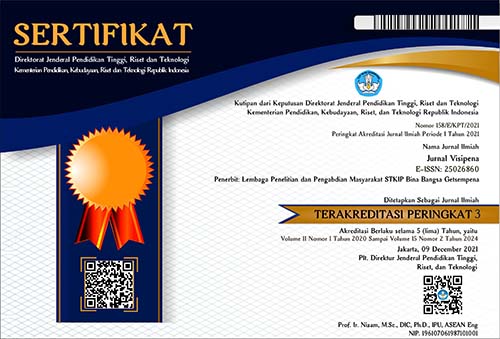ASSESSING STUDENTS’ LEARNING IN PROJECT-BASED LEARNING APPROACH
Abstract
Students’ passive learning has motivated educators constantly to seek innovative ways to encourage students and improve their learning outcomes. Project-Based Learning (PBL) may be a particularly productive method for transforming practice in ways that support students learning. However, the implementation of PBL is challenging because it requires substantial change to teaching and assessment. The purpose of this paper is to explore new assessment methods that are needed in assessing students’ performance in PBL and how teachers can employ these methods in their practices. The insights provided by Project-Based Learning approach are essential for promoting effective teaching and learning. PBL provides students with an opportunity to engage in the learning process by working collaboratively to solve real-world problem. Moreover, PBL offers the potential to help students become reflective and flexible thinkers who can use knowledge to take an action. This paper emphasizes that the formative approach should be integrated throughout the assessment process, but it should be balanced with observation and tests or tasks in order to provide comprehensive information about student progress and outcomes. Sustained project-based learning is not a simple task for teachers, therefore, teachers need to be involved in professional development programs to get more understanding about what and how assessment might be realized in the project-based approach.
Downloads
References
Black , P., & William, D, “Developing theory of formative assessment”, Education Assessment Evaluation, Vol 21, 2009, pages. 5-31.
Blumenfeld, P.C., Soloway, E., Marx, R.W., Krajcik, J. S., Guszial, M., Palinscar, A, “Motivating Project-based Learning : Sustaining the doing, Supporting the learning”, Educational Psychologist, Vol 26, 1991, pages. 369-398.
Broadfoot, P., & Black, P. (2004), “Redifining Assessment? The first ten years of assessment in education”, Assessement in Education, Vol.11, No. 1, 2004, pages.7-27.
Brush, T., & Saye, J, “Implementation and evaluation of student-centered learning unit: A case study”, Educational Technology Research & Development, Vol. 48, No. 3, 2000,pages. 79-100.
Buck Institute for Education, “Project Based Learning” [online]. http://www.bie.org/pbl/pbloverview/defenition.php viewed 10 April 2010.
Chang, L.C, & Lee, G. C, A team-teaching model for practicing project-based learning in High School: Collaboration between computer and subject teachers. Computer and Education, Vol. 30, 2010, pages. 1-9.
David, S, Purposes of Portfolio Assessment, eHow [online], http://www.ehow.com/about_5103845_purposes-portfolio-assessment.html, viewed 9/6/2010.
Diezmann, C. M, Assessing learning from Mathematics inquiry: the challenges for students, teachers, and researchers. In proceedings Mathematical Association of Victoria Conference Melbourne, 2004, pages. 80-85.
DeFilippi, J.R, “Introduction: Project-Based Learning, Reflective, Practices and Learning”, Management Learning, Vol. 32, No.1, 2001. Pages. 5-10.
Doppelt, Y, “Assesing creative thinking in design-based learning”, International Journal of Technology Education, Vol. 19, 2009, pages. 55-65.
Fang, R.J, Chiang, W.J, lih-Jiuan, T, Wang, L.H, Tsai, H.L, & Chen, Z. G, “The challenge of primer educator in project-based learning model. In 8th WSEAS International Conferences on Multimedia System and Signal Processing, Hangzho, China, 2008, pages. 176-179.
Fortuny, J.M, Gimenez, G,& Alsina, C, “ Integrated assessment on mathematics”, Educational Studies in Mathematics, Vol. 27, 1994, pages. 401-412.
Ginsburg, H. P, “The Challenge of formative assessment in mathematics education: Childrens’ Minds, teachers’ minds. Human Development, Vol. 52, 2009, pages. 109-128.
Grant, M. M & Branch, R. M, “Project Based Learning in a Middle School: Tracing Abilities through the artifacts of Learning”, Journal of Research on technology in Education, Vol. 38, No. 1, Pages. 65-98.
Grant, M.M, “Understanding project based learning: A students’ perspective. Paper presented ath the annual Conferences of American Educational research Association, April 13-17, 2009, San Diego, California.
Hattie, J & Kimberley, H, “The power of feedback”, Review of Educational Research, Vol. 77, No. 1, 2007, pages 81-94.
Kilpatrick, W.H, “The Project Method”, Teacher College Record, Vol. 19, 1918, pages. 319-335.
Liu, M & Hsio, Y, “Middle school students as multimedia designer: A project-based learning approach”, Journal of International Interactive Learning Research, Vol. 13, No. 4, 2002, pages. 311-337.
Marsh, C, “Handbooks for the beginning teacher 2nd edition. Melbourne: Pearson Education Australia, 2000.
Parson, J, “Portfolios in Education”, Adult Learning, Vol. 9, No. 4, 1994, pages 28-31.
Pearlman, B, “ Getting and Assessing 21st Century Knowledge and Skills ppt”, http://www.bobpearlman.org/BLC2009.html, viewed 5/4/2010.
Project-based Learning with Multimedia, Assessing students’work with project-based learning, http://homepage.mac.com/seilts/udl_at/resouces/Assessment/Assessment %20and %20PBL.pdf., Viewed &June 2010.
Spronken-Smith, R & Harland, T, “ Learning to teach with problem based learning”, Active Learning in Higher Education, Vol. 10. No.2, 2009, pages. 138-153.
Thaler, N, Kazemi, E & Huscher, C, “Developing rubric to assess student learning outcome using class assignment”, Teaching of Psychology, Vol. 36, 2009, pages. 113-116.
Thomas, J.W,”A review o researchon project-based learning, http://www.autodesk.com/foundation, viewed on 4/6/2010.
Ullah, L, “Project-Based Learning”, A Web Quest for Educator, http://www.lullah.com/pblwebquest/, viewed 10/4/ 2010.
Vygotsky, L.S, “Mind in Society; The development of higher psychological processes. Cambridge, MA: Harvard University Press, 1978





















